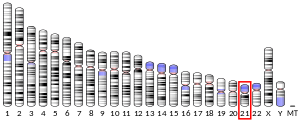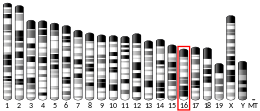SON (gene)
SON protein is a protein that in humans is encoded by the SON gene.[5][6]
SON is the name that has been given to a large Ser/Arg (SR)-related protein, which is a splicing co-factor that contributes to an efficient splicing within cell cycle progression.[7] It is also known as BASS1 (Bax antagonist selected in saccharomyces 1) or NRE-binding protein (Negative regulatory element-binding protein). The most common gene name of this splicing protein- which is only found in Humans (Homo sapiens)- is SON, but C21orf50, DBP5, KIAA1019 and NREBP can also be used as synonyms.[8]
The protein encoded by SON gene binds to a specific DNA sequence upstream of the upstream regulatory sequence of the core promoter and second enhancer of human hepatitis B virus (HBV). Through this binding, it represses HBV core promoter activity, transcription of HBV genes, and production of HBV virions. The protein shows sequence similarities with other DNA-binding structural proteins such as gallin, oncoproteins of the MYC family, and the oncoprotein MOS. It may also be involved in protecting cells from apoptosis and in pre-mRNA splicing.[6] Mutation in SON gene is associated with ZTTK syndrome.[9]
Structure
The sequence length of the SON protein consists in 2426 aminoacids and its sequence status is totally completed. Its molecular weight is 263,830 Daltons (Da) and its domain contains 8 types of repeats which are distributed in 3 regions. This protein is found in the 21st chromosome and is mostly located in nuclear speckles. Its higher expression is seen in leukocyte and heart cells.[8][10]
Splicing process

SON protein is essential for maintaining the subnuclear organization of the factors that are processed in the nucleus highlighting its direct role in pre-mRNA splicing.[11]
Splicing is known as the process within the maturation of the pre-RNAm takes place. The pre-RNAm which has just been transcript has sequences called introns and exons. Introns are non-active nucleotide sequences that have to be removed in order the exons (active sequences) to get joined. This process must be very controlled. The splicing takes place in the spliceosome, a complex that brings together a pre-RNAm and a variety of the binding proteins. These proteins together with the splicing factors (which are not found in the spliceosome) are in charge of recognizing the intron’s branch point sequence. The SON protein is known to be one of these binding proteins.[11]
Although there is a lack of knowledge about its exact splicing control in the progression of the cell cycle and it has remained largely unexplored, it’s certain that this splicing-associated protein is necessary for the maintenance of the embryonic stem cells because it influences the splicing of pluripotency regulators.[7][12]
SON plays an important role in the mRNA processing. Nevertheless, this process is still a little uncertain and this is why in a future it will be interesting to understand how exactly this protein interacts with the spliceosomal complex, its exact molecular function in the context of splicing. Not only the SON protein interferes in the splicing but also makes complex mechanisms such as the RNA post-transcriptional to cooperate with the splicing-mRNA processing.[13]
Human embryonic stem cells are able to undergo the process of differentiation into specific and relevant cells. To maintain the pluripotency of the embryonic stem cells, transcription factors and epigenetic modifiers play an important role despite the fact that little is known about the regulation of pluripotency throughout the process of splicing. The factor SON is identified as essential for the maintenance of this pluripotency. It is confirmed that SON regulates the splicing process of transcripts (RNAm) that will encode the gens that are going to regulate the pluripotency of the embryonic human cells.[14]
Function

On the one hand, SON protein is required to maintain the genome stability in order to ensure an efficient RNA processing of affected genes. It also facilitates the interaction of SR proteins with RNA polymerase II and is required for processing of weak constitutive splice sites, having also strong implications in cancer and other human diseases.[7][10]
On the other side, a deficiency or knockdown of SON protein causes various and severe defects in mitotic division arrangement, chromosome alignment and microtubule dynamics when spindle pole separation takes place.[7]
But as we could read in the article called “SON protein regulates GATA-2 through transcriptional control of the microRNA 23a-27-24-a clúster”, SON protein has even more functions in the organism. It has been found that these proteins may regulate the hematopoietic cells differentiation. They have a specific job in hematopoietic process, which is based on activating other proteins called GATA. As these ones are finally activated, the cell differentiation starts normally.[15]
Clinical significance
A recent study suggested that SON may be a novel therapeutic molecular target for pancreatic cancer as the results of a recent study show that this protein is very important as far as proliferation, survival and tumorigenicity of cancer cells are concerned. Specifically, these results revealed that the serine-arginine-rich protein involved in the RNA splicing process, could suppress pancreatic cell tumorigenicity.[13]
References
- GRCh38: Ensembl release 89: ENSG00000159140 - Ensembl, May 2017
- GRCm38: Ensembl release 89: ENSMUSG00000022961 - Ensembl, May 2017
- "Human PubMed Reference:". National Center for Biotechnology Information, U.S. National Library of Medicine.
- "Mouse PubMed Reference:". National Center for Biotechnology Information, U.S. National Library of Medicine.
- Cheng S, Lutfalla G, Uze G, Chumakov IM, Gardiner K (Aug 1993). "GART, SON, IFNAR, and CRF2-4 genes cluster on human chromosome 21 and mouse chromosome 16". Mamm Genome. 4 (6): 338–42. doi:10.1007/BF00357094. PMID 8318737.
- "Entrez Gene: SON SON DNA binding protein".
- Ahn EY, DeKelver RC, Lo MC, Nguyen TA, Matsuura S, Boyapati A, Pandit S, Fu XD, Zhang DE (April 2011). "SON controls cell-cycle progression by coordinated regulation of RNA splicing". Mol. Cell. 42 (2): 185–98. doi:10.1016/j.molcel.2011.03.014. PMC 3137374. PMID 21504830.
- "Protein SON". UniProt Consortium.
- "OMIM Entry- # 617140 - ZTTK SYNDROME; ZTTKS". omim.org. Retrieved 2017-10-27.
- "Son peptide". MyBioSource.com.
- Voet D, Voet JG (2011). Biochemistry. Hoboken, NJ: John Wiley Sons. ISBN 978-0-470-57095-1.
- Livyatan I, Meshorer E (October 2013). "SON sheds light on RNA splicing and pluripotency". Nat. Cell Biol. 15 (10): 1139–40. doi:10.1038/ncb2851. PMID 24084863.
- Furukawa T, Tanji E, Kuboki Y, Hatori T, Yamamoto M, Shimizu K, Shibata N, Shiratori K (2012). "Targeting of MAPK-associated molecules identifies SON as a prime target to attenuate the proliferation and tumorigenicity of pancreatic cancer cells". Mol. Cancer. 11: 88. doi:10.1186/1476-4598-11-88. PMC 3576306. PMID 23227827.
- Lu X, Göke J, Sachs F, Jacques PÉ, Liang H, Feng B, Bourque G, Bubulya PA, Ng HH (October 2013). "SON connects the splicing-regulatory network with pluripotency in human embryonic stem cells". Nat. Cell Biol. 15 (10): 1141–52. doi:10.1038/ncb2839. PMC 4097007. PMID 24013217.
- Ahn EE, Higashi T, Yan M, Matsuura S, Hickey CJ, Lo MC, Shia WJ, DeKelver RC, Zhang DE (February 2013). "SON protein regulates GATA-2 through transcriptional control of the microRNA 23a~27a~24-2 cluster". J. Biol. Chem. 288 (8): 5381–8. doi:10.1074/jbc.M112.447227. PMC 3581430. PMID 23322776.
Further reading
- Mattioni T, Hume CR, Konigorski S, et al. (1992). "A cDNA clone for a novel nuclear protein with DNA binding activity". Chromosoma. 101 (10): 618–24. doi:10.1007/BF00360539. PMID 1424986.
- Bliskovskiĭ VV, Berdichevskiĭ FB, Tkachenko AV, et al. (1992). "[Coding part of the son gene small transcript contains four areas of complete tandem repeats]". Mol. Biol. (Mosk.). 26 (4): 793–806. PMID 1435773.
- Bliskovskiĭ VV, Kirillov AV, Zakhar'ev VM, Chumankov IM (1992). "[The human son gene: the large and small transcripts contains various 5'-terminal sequences]". Mol. Biol. (Mosk.). 26 (4): 807–12. PMID 1435774.
- Tassone F, Cheng S, Gardiner K (1993). "Analysis of chromosome 21 yeast artificial chromosome (YAC) clones". Am. J. Hum. Genet. 51 (6): 1251–64. PMC 1682922. PMID 1463009.
- Chumakov IM, Berdichevskiĭ FB, Sokolova NV, et al. (1991). "[Identification of a protein product of a novel human gene SON and the biological effect upon administering a changed form of this gene into mammalian cells]". Mol. Biol. (Mosk.). 25 (3): 731–9. PMID 1944255.
- Berdichevskiĭ FB, Chumakov IM, Kiselev LL (1988). "[Decoding of the primary structure of the son3 region in human genome: identification of a new protein with unusual structure and homology with DNA-binding proteins]". Mol. Biol. (Mosk.). 22 (3): 794–801. PMID 3054499.
- Khan IM, Fisher RA, Johnson KJ, et al. (1994). "The SON gene encodes a conserved DNA binding protein mapping to human chromosome 21". Ann. Hum. Genet. 58 (Pt 1): 25–34. doi:10.1111/j.1469-1809.1994.tb00723.x. PMID 8031013.
- Kikuno R, Nagase T, Ishikawa K, et al. (1999). "Prediction of the coding sequences of unidentified human genes. XIV. The complete sequences of 100 new cDNA clones from brain which code for large proteins in vitro". DNA Res. 6 (3): 197–205. doi:10.1093/dnares/6.3.197. PMID 10470851.
- Greenhalf W, Lee J, Chaudhuri B (1999). "A selection system for human apoptosis inhibitors using yeast". Yeast. 15 (13): 1307–21. doi:10.1002/(SICI)1097-0061(19990930)15:13<1307::AID-YEA455>3.0.CO;2-3. PMID 10509013.
- Hattori M, Fujiyama A, Taylor TD, et al. (2000). "The DNA sequence of human chromosome 21". Nature. 405 (6784): 311–9. doi:10.1038/35012518. PMID 10830953.
- Wynn SL, Fisher RA, Pagel C, et al. (2001). "Organization and conservation of the GART/SON/DONSON locus in mouse and human genomes". Genomics. 68 (1): 57–62. doi:10.1006/geno.2000.6254. PMID 10950926.
- Sun CT, Lo WY, Wang IH, et al. (2001). "Transcription repression of human hepatitis B virus genes by negative regulatory element-binding protein/SON". J. Biol. Chem. 276 (26): 24059–67. doi:10.1074/jbc.M101330200. PMID 11306577.
- Reymond A, Friedli M, Henrichsen CN, et al. (2002). "From PREDs and open reading frames to cDNA isolation: revisiting the human chromosome 21 transcription map". Genomics. 78 (1–2): 46–54. doi:10.1006/geno.2001.6640. PMID 11707072.
- Yi J, Kloeker S, Jensen CC, et al. (2002). "Members of the Zyxin family of LIM proteins interact with members of the p130Cas family of signal transducers". J. Biol. Chem. 277 (11): 9580–9. doi:10.1074/jbc.M106922200. PMID 11782456.
- Strausberg RL, Feingold EA, Grouse LH, et al. (2003). "Generation and initial analysis of more than 15,000 full-length human and mouse cDNA sequences". Proc. Natl. Acad. Sci. U.S.A. 99 (26): 16899–903. doi:10.1073/pnas.242603899. PMC 139241. PMID 12477932.
- Casadei R, Strippoli P, D'Addabbo P, et al. (2004). "mRNA 5' region sequence incompleteness: a potential source of systematic errors in translation initiation codon assignment in human mRNAs". Gene. 321: 185–93. doi:10.1016/S0378-1119(03)00835-7. PMID 14637006.
- Ota T, Suzuki Y, Nishikawa T, et al. (2004). "Complete sequencing and characterization of 21,243 full-length human cDNAs". Nat. Genet. 36 (1): 40–5. doi:10.1038/ng1285. PMID 14702039.
- Hillman RT, Green RE, Brenner SE (2005). "An unappreciated role for RNA surveillance". Genome Biol. 5 (2): R8. doi:10.1186/gb-2004-5-2-r8. PMC 395752. PMID 14759258.
- Colland F, Jacq X, Trouplin V, et al. (2004). "Functional proteomics mapping of a human signaling pathway". Genome Res. 14 (7): 1324–32. doi:10.1101/gr.2334104. PMC 442148. PMID 15231748.






